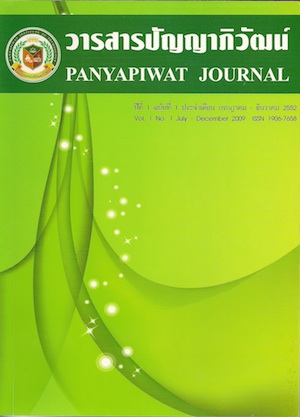How to build learning organization
Main Article Content
บทคัดย่อ
บทคัดย่อ
บทความนี้มีวัตถุประสงค์เพื่อให้ผู้อ่านเข้าใจเรื่ององค์การแห่งการเรียนรู้และสามารถนำแนวคิดในการสร้างองค์การแห่งการเรียนรู้ไปปรับปรุงพัฒนาคุณภาพและผลิตภาพขององค์การให้สูงขึ้น โดยเริ่มจากการศึกษากระบวนการการเรียนรู้และการพัฒนาความรู้ของพนักงาน รวมถึงการทำงานร่วมกันของฝ่ายต่างๆในองค์การ ซึ่งการสร้างองค์การแห่งการเรียนรู้นี้สามารถทำได้โดยการนำรูปแบบของทฤษฏีองค์การแห่งการเรียนรู้ไปประยุกต์ใช้ให้เกิดความต้องการเรียนรู้ การพัฒนาความรู้และกระบวนการในการถ่ายทอดความรู้ระหว่างกันของพนักงานในองค์การ ซึ่งองค์การสมัยใหม่ต่างส่งเสริมการพัฒนาทรัพยากรบุคคล และปลูกฝังให้บุคลากรของตนรักในการเรียนรู้เพื่อพัฒนาตนเองและเปลี่ยนองค์การของตนให้เป็นองค์การแห่งการเรียนรู้ที่สมบูรณ์แบบ บทความนี้แบ่งออกเป็นสี่ส่วนที่สำคัญอันได้แก่
1. คำนิยามขององค์การแห่งการเรียนรู้ ประเภทและการจัดการองค์ความรู้ตลอดจนระดับของการเรียนรู้
2. อธิบายองค์ประกอบขององค์การแห่งการเรียนรู้
3. อธิบายวินัยทั้งห้าของการสร้างองค์การแห่งการเรียนรู้รวมถึงหกขั้นตอนที่สำคัญในการทำให้องค์การเป็นองค์การแห่งการเรียนรู้ที่สมบูรณ์
4. การเรียนรู้ในระดับบุคคล การเรียนรู้ในระดับองค์การและเปรียบเทียบองค์การแบบดั้งเดิมกับองค์การสมัยใหม่
คำสำคัญ : องค์กรแห่งการเรียนรู้, การจัดการเรียนรู้, ความรู้ประจักษ์, ความรู้แอบแฝง
Abstract
The purpose of this article is to provide understanding and apply the concept of learning organization for the high productivity improving. The initial ideas is to eventually explore how people learn and create knowledge, together through interaction and practices by applying the model that could increase learner’s consciousness about knowledge creation and knowledge sharing processes. Some virtual modern organizations intellectually can create and transform how to develop the human resources in the learning organization. The contributions of this article are fourfold. First, what the definition of learning organization is, type, and level of learning. Second,describe the subset of learning organization. Third, describe the core fifth disciplines of learning organization, and six actions for implementation. Fourth, People with learning, Organization with learning, and comparison between traditional and modern organization is demonstrated.
Keyword : Learning Organization, Knowledge Management, Explicit Knowledge, Implicit Knowledge
Article Details
“ข้าพเจ้าและผู้เขียนร่วม (ถ้ามี) ขอรับรองว่า บทความที่เสนอมานี้ยังไม่เคยได้รับการตีพิมพ์และไม่ได้อยู่ระหว่างกระบวนการพิจารณาลงตีพิมพ์ในวารสารหรือแหล่งเผยแพร่อื่นใด ข้าพเจ้าและผู้เขียนร่วมยอมรับหลักเกณฑ์การพิจารณาต้นฉบับ ทั้งยินยอมให้กองบรรณาธิการมีสิทธิ์พิจารณาและตรวจแก้ต้นฉบับได้ตามที่เห็นสมควร พร้อมนี้ขอมอบลิขสิทธิ์บทความที่ได้รับการตีพิมพ์ให้แก่สถาบันการจัดการปัญญาภิวัฒน์หากมีการฟ้องร้องเรื่องการละเมิดลิขสิทธิ์เกี่ยวกับภาพ กราฟ ข้อความส่วนใดส่วนหนึ่งและ/หรือข้อคิดเห็นที่ปรากฏในบทความข้าพเจ้าและผู้เขียนร่วมยินยอมรับผิดชอบแต่เพียงฝ่ายเดียว”
เอกสารอ้างอิง
Argyris, C. (2006). Organizational learning.Massachusetts: Addison Wesley.
David Skyrme Associates. (2008). Type oflearning. Retrieved November 1, 2008,from Knowledge Connections Web site:http://www.skyrme.com/insights/3lrmorg.htm
Dixon, N. (1994). The Organizational learningcycle. London: McGraw-Hill.
Faerman, S. (1996). Wheel of learning. Retrieved February 11, 2008, from Learning Loop web site: http:/www.home.nycap.rr.com/klarsen/learnorg
General Electric Company. (2009). Retrieved June 18, 2009, from GE imagination at work Web site: http:/www.ge.com/company/culture/lead
Marquardt, M. (Dipl-ing. Bodinth Wicharn, tr.)(2006). Building the learning organization:Mastering the 5 element for corporate learning. Bangkok: EXPERTNET.
Meiners, F. (1986). Corporate Social Responsibility. Retrieved June 22, 2009, from CSR Web site: http: www.en.wikipedia.org.wiki.csr
Narvan Associates newsletter. (1993). Retrieved March 16, 2007, from The learning organization web site: http://www.moyak.com/researcher/papers/var21mkm.html
Nonaka, I and Takeuchi, H. (1995). The knowledge creating company. New York:Oxford University press.
Pedler, M., Burgoyne, J., and Boydell, J. (1991).The learning company. New York: McGrawHill.
Rheem, H. (1995). The learning organization,Harvard Business Review, 73(2), 10.Senge, P., Kleiner, A., Roberts, C., Ross, R.,and Smith, B. (1994). The fifth discipline fieldbook: Strategies and tools for building a learning organization. NewYork: Doubleday.
Senge, P. (2006). The fifth discipline: The art& practice of the learning organization.New York: Doubleday.Stephen, P., Robbins, C., and Mary, K. (1999).Management. New York: McGraw-Hill.
Takhumthong, P. (2007). Modern organization.Udonthani: Rajabhat Udonthani University.
Watkins, E. and Marsick, J. (1992). Learning organization. Retrieved June 26, 2009,from Dimensions of the learning organization Web site: http://www.infed.org/biblio/learning-organization.htm


